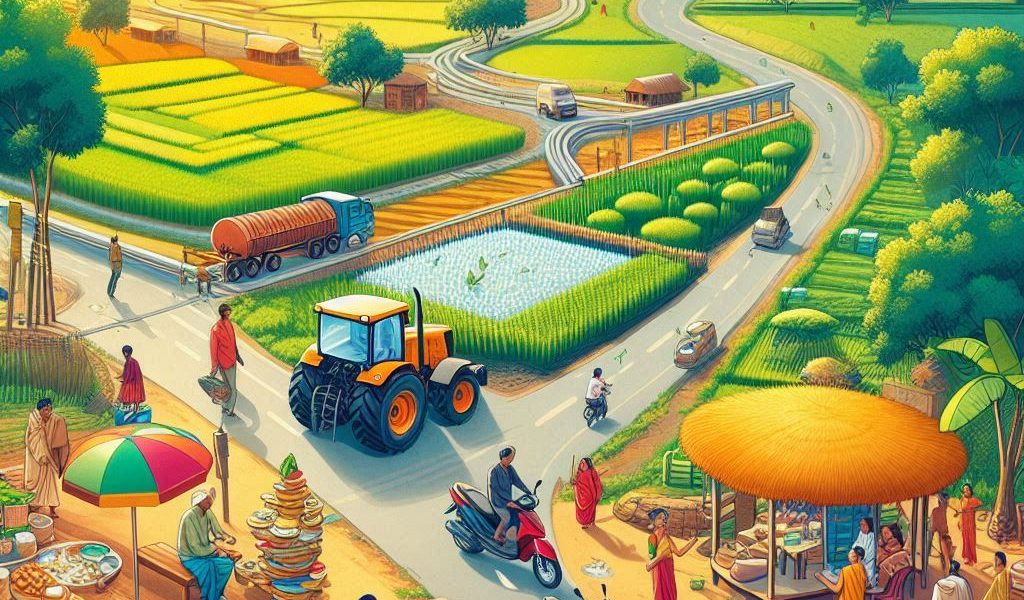The rural economy plays a crucial role in India’s overall economic growth, providing employment to nearly two-thirds of the population. However, rural areas often struggle with inadequate infrastructure, low productivity, and financial instability. To address these challenges, the Indian government has implemented various grants and subsidy programs to empower rural communities, promote entrepreneurship, and enhance agricultural and non-agricultural sectors. In this article, we will explore how government grants are boosting the rural economy, the key subsidy programs, and how individuals can avail themselves of these benefits.
The Importance of Government Grants in Rural Development
Government grants and subsidies serve as essential tools to bridge the economic gap between urban and rural areas. These financial aids help in:
- Increasing agricultural productivity
- Encouraging rural entrepreneurship
- Supporting small businesses and cottage industries
- Enhancing rural infrastructure
- Providing employment opportunities
- Reducing migration to urban areas
By leveraging these grants, rural communities can achieve sustainable economic growth and self-reliance.
Key Government Grant Programs Supporting the Rural Economy
The Indian government offers various schemes to support different sectors of the rural economy. Here are some of the most significant ones:
1. Pradhan Mantri Kisan Samman Nidhi (PM-KISAN)
This scheme provides direct income support to small and marginal farmers to ensure financial stability.
- Grant Details: Eligible farmers receive ₹6,000 per year in three equal installments.
- Eligibility: Small and marginal farmers with landholding up to 2 hectares.
- Application Process: Farmers can register through their state agriculture department or online via the PM-KISAN portal.
2. Mahatma Gandhi National Rural Employment Guarantee Act (MGNREGA)
Aimed at providing employment security, MGNREGA guarantees 100 days of wage employment to rural households.
- Grant Details: Government funds wage payments for rural workers involved in public work projects.
- Eligibility: Any rural household willing to do unskilled labor can apply.
- Application Process: Applications can be submitted through Gram Panchayats.
3. Pradhan Mantri Gram Sadak Yojana (PMGSY)
This scheme focuses on improving rural infrastructure by constructing all-weather roads.
- Grant Details: Fully funded by the government to ensure connectivity for remote villages.
- Eligibility: Villages with no prior road connectivity.
- Application Process: Implemented through state rural development agencies.
4. Stand-Up India Scheme
To promote rural entrepreneurship among women and SC/ST communities, this scheme provides financial support to establish businesses.
- Grant Details: Bank loans from ₹10 lakh to ₹1 crore with government-backed support.
- Eligibility: Entrepreneurs belonging to SC/ST categories or women entrepreneurs.
- Application Process: Apply through the Stand-Up India portal or designated banks.
5. Deendayal Antyodaya Yojana – National Rural Livelihood Mission (DAY-NRLM)
A flagship program aimed at empowering self-help groups (SHGs) and promoting sustainable livelihoods.
- Grant Details: Revolving funds, interest subvention, and financial assistance for micro-enterprises.
- Eligibility: Rural poor organized into SHGs.
- Application Process: Implemented through self-help groups and state rural livelihood missions.
6. Rashtriya Krishi Vikas Yojana (RKVY)
This scheme supports agriculture and allied sectors by providing funds for innovative farming practices.
- Grant Details: Funding for organic farming, infrastructure, and value-added processing.
- Eligibility: Farmers, cooperatives, and agricultural startups.
- Application Process: Apply through state agriculture departments.
7. PM Formalization of Micro Food Processing Enterprises (PMFME) Scheme
Encouraging the food processing industry in rural areas, this scheme provides financial aid to micro-enterprises.
- Grant Details: 35% subsidy of the total project cost, up to ₹10 lakh.
- Eligibility: Individual micro-entrepreneurs and farmer-producer organizations.
- Application Process: Apply via the PMFME portal.
Impact of Government Grants on the Rural Economy
The implementation of these grants has significantly contributed to rural development in India. Here are some key impacts:
1. Increase in Agricultural Productivity
With financial assistance for modern farming techniques, irrigation facilities, and organic farming, farmers have witnessed improved crop yields and profitability.
2. Growth of Rural Industries
Grants supporting micro, small, and medium enterprises (MSMEs) have led to a surge in cottage industries, handicrafts, and food processing units.
3. Reduction in Rural Unemployment
Schemes like MGNREGA and Stand-Up India have generated employment opportunities, reducing rural migration to cities.
4. Better Infrastructure and Connectivity
PMGSY has significantly enhanced rural connectivity, facilitating smoother transport of goods and services.
5. Women Empowerment
Government grants aimed at women entrepreneurs have encouraged financial independence and business ownership among rural women.
Challenges in Availing Government Grants
While these grants have positively impacted rural development, some challenges persist:
- Lack of Awareness: Many rural beneficiaries are unaware of the available grants.
- Complex Documentation: Tedious paperwork and bureaucratic procedures hinder access.
- Delayed Disbursement: Fund disbursement processes can sometimes be slow.
- Corruption and Middlemen: Some beneficiaries face difficulties due to corruption at local levels.
How to Apply for Government Grants?
To successfully avail government grants, follow these steps:
- Identify the Right Scheme: Research the grants that match your needs.
- Check Eligibility: Ensure that you meet the criteria before applying.
- Gather Required Documents: Essential documents may include Aadhaar card, land records, business registration, bank details, etc.
- Apply Online or Offline: Most schemes have an online portal for applications, while some require submission at government offices.
- Track Application Status: Follow up on your application to ensure timely approval and disbursement.
Conclusion
Government grants are playing a transformative role in strengthening India’s rural economy. By providing financial aid for agriculture, entrepreneurship, employment, and infrastructure, these schemes are paving the way for a self-reliant and prosperous rural sector. To maximize the benefits, rural beneficiaries should stay informed about available grants, seek assistance from local authorities, and leverage digital platforms for easy application.
For more details, visit official government portals such as https://www.nabard.org and https://www.rural.nic.in.



